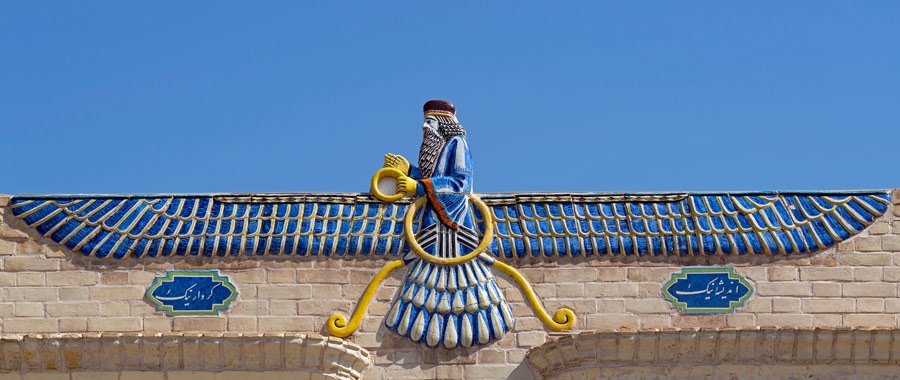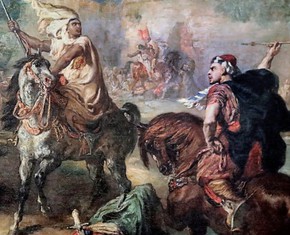The views expressed in our content reflect individual perspectives and do not represent the authoritative views of the Baha'i Faith.
Most prophecies, if taken literally, would never come true – they could never happen unless the laws of nature were suspended.
Most apocalyptic prophecies – visions of the end – involve grand scenarios, remarkable events that, ordinarily considered, would otherwise be highly improbable, if not impossible.
Their truth, moreover, is not in what they outwardly say, but what they inwardly mean. In some cases, fulfillment of some prophecies would not be good for the world, anyway – such as prophecies of a savior waging an apocalyptic war.
A case-in-point: the set of Zoroastrian prophecies about the sun standing still. Zoroastrianism is one of the world religions – although the current number of Zoroastrians today is small, such that, unfortunately, Zoroastrianism may be a dying religion. In its heyday, however, the religion of Zoroaster (who lived around 1,000 years before Christ) was a great world Faith, influencing Jewish and Christian – and, by extension, Islamic – beliefs about the afterlife and the future of the world. For instance, the concept of a heavenly “Paradise” – and even the very word itself – is borrowed from the original Persian.
Since the former Zoroastrian languages of Pahlavi and Pazand were unfamiliar to most Zoroastrians in nineteenth-century Persia [now Iran], the following prophecy, in “New Persian,” was much more accessible to lay, everyday Zoroastrian believers. This prophecy – about the sun standing still – is as follows:
Then Oshedar comes to Behram Varjavand for apostleship. He performs a miracle and cries out to the sun: “Stand still!” The sun with the swift horse stands still. It stands still in the midst of the sky for 10 days and nights. All men abide by the religion of Oshedar. Then Meher of the wide pastures cries out: “O Oshedar, the Zarothushtrōtcmō, restorer of the true religion! Cry out to the sun with the swift horse (to move on), for it is dark in the regions of Arzah, Savah, Fradadafsh, Vidadafsh, Vorubarast, Vorujarast.” Then Oshedar, son of Zartosht [Zoroaster], cries out to the sun: “Move on, O sun with the swift horse!” Then it moves on and all men believe in the good religion [Zoroastrianism] and they accept it. And when the time of Oshedar comes to an end, then will come Oshedar Māh Bāmi. The millennium of Oshedar Māh Bāmi commences and Oshedar Māh goes to the conference of Ormazd [God], accepts the religion in its entirety and propagates it in the world, and, as a miracle, the sun will stand still for 20 days and nights in the midst of the sky, his movement will become still and he will not revolve. When the people of the world see this, two-thirds of them will be steadfast in the religion and will fix their hearts on the laws of God. …
It is evident that in the time of Oshedar, the sun stands still for 10 days and nights in the midst of the sky and (in the time of) Oshedar Māh he stands still for 20 days and nights and (in the time of) Sāshān, for 30 days and nights in the midst of the sky so that tho [though] the people of the world may be without any doubt about the religion of the Creator, and may offer prayers unto God and fix their minds rightly on Him. – Persian Rivayats, pp. 470–472.
Here, this Zoroastrian prophecy speaks of three Zoroastrian saviors, or messiahs – Oshedar, Oshedar Māh, and Sāshān – each of whom perform the miracle of commanding the sun to stand still. What does this miracle – causing the sun to remain motionless in the sky for 10 days, then 20 days, then 30 days – actually mean?
It’s easiest to explain what this prophecy does not mean: here, the “sun” is not the physical sun, but the spiritual “sun.” By causing the sun to remain in the zenith of the sky, the sun does not set. The day of God, as it were, is prolonged. Spiritual illumination and guidance, during each of these three events, lasts for a symbolic period of time. Note also that these prophecies anticipate the restoration of Zoroastrianism’s former prestige and influence.
“As a further testimony to the greatness of the Revelation identified with Baha’u’llah,” wrote Shoghi Effendi, the Guardian of the Baha’i Faith from 1921–1957, “may be cited the following extracts from a Tablet addressed by Abdu’l-Baha to an eminent Zoroastrian follower of the Faith:”
Thou hadst written that in the sacred books of the followers of Zoroaster it is written that in the latter days, in three separate Dispensations, the sun must needs be brought to a standstill. In the first Dispensation, it is predicted, the sun will remain motionless for ten days; in the second for twice that time; in the third for no less than one whole month. The interpretation of this prophecy is this: the first Dispensation to which it refers is the Muḥammadan Dispensation during which the Sun of Truth stood still for ten days. Each day is reckoned as one century. The Muḥammadan Dispensation must have, therefore, lasted no less than one thousand years, which is precisely the period that has elapsed from the setting of the Star of the Imamate to the advent of the Dispensation proclaimed by the Bab. The second Dispensation referred to in this prophecy is the one inaugurated by the Bab Himself, which began in the year 1260 A.H. [1844 C.E.] and was brought to a close in the year 1280 A.H [1863 C.E.]. As to the third Dispensation – the Revelation proclaimed by Baha’u’llah – inasmuch as the Sun of Truth when attaining that station shineth in the plenitude of its meridian splendor its duration hath been fixed for a period of one whole month, which is the maximum time taken by the sun to pass through a sign of the Zodiac. From this thou canst imagine the magnitude of the Baha’i cycle – a cycle that must extend over a period of at least five hundred thousand years. – Abdu’l-Baha, translated by Shoghi Effendi, The World Order of Baha’u’llah, pp. 101–102.
So Abdu’l-Baha identifies the three Zoroastrian messiahs as follows: (1) “Oshedar” refers to the Prophet Muhammad; (2) “Oshedar Māh” refers to the Bab, the co-founder of the Baha’i Faith; and (3) “Sāshān” is Baha’u’llah, the other co-founder of the Baha’i Faith.
Abdu’l-Baha further interpreted this Zoroastrian prophecy as follows: (1) the sun standing still for 10 days represents 1,000 lunar years, from the year 260 A.H. (of the Muslim calendar) to the year 1260 A.H. (= 1844 C.E.), which is when the prophetic cycle of Muhammad ended; (2) the 20 days that the sun stood still stands for the 20 lunar years – from 1260 A.H. [1844 C.E.] to 1280 A.H [1863 C.E.], which is the short duration of the ministry of the Bab; and (3) the 30 days signifies “a period of at least five hundred thousand years.”
In the next article in this series, we’ll explore how the Zoroastrian prophecies of the sun standing still presage and proclaim the greatness of this day and age.
















Comments
Sign in or create an account
Continue with Googleor